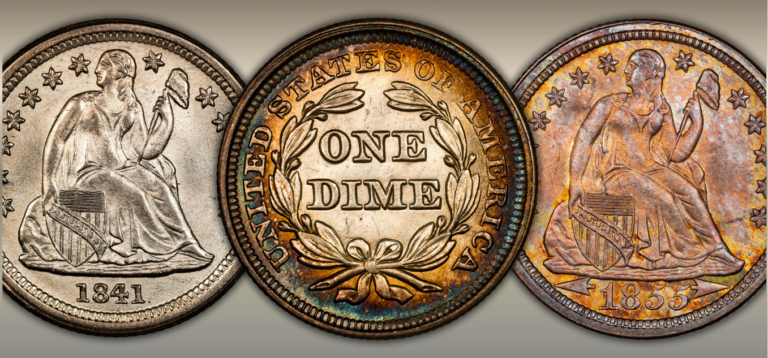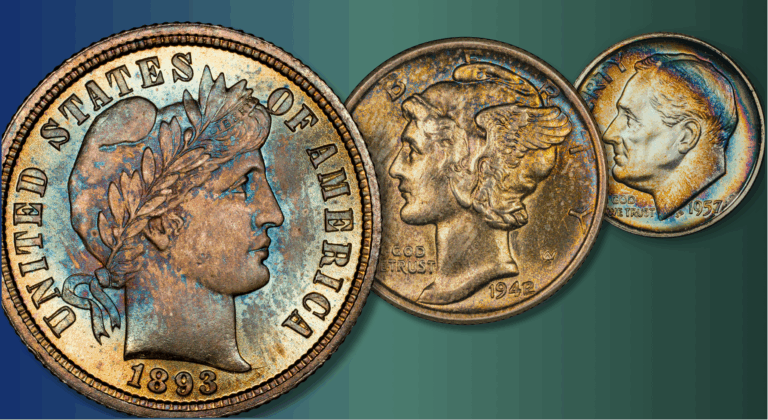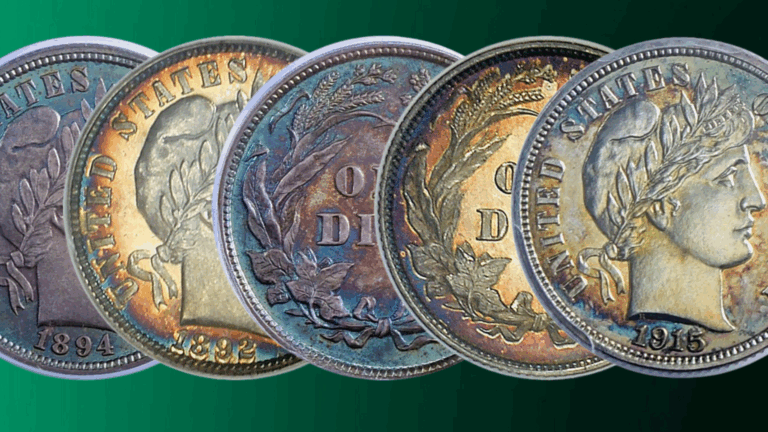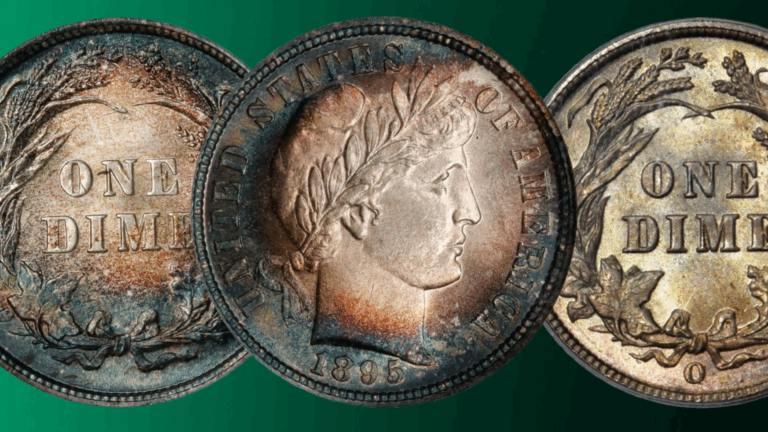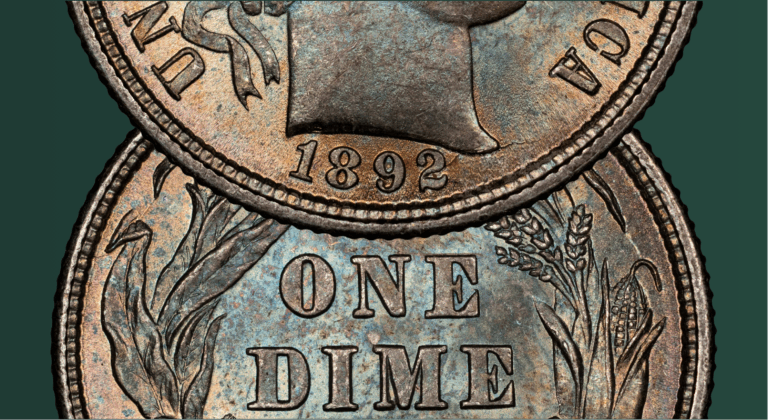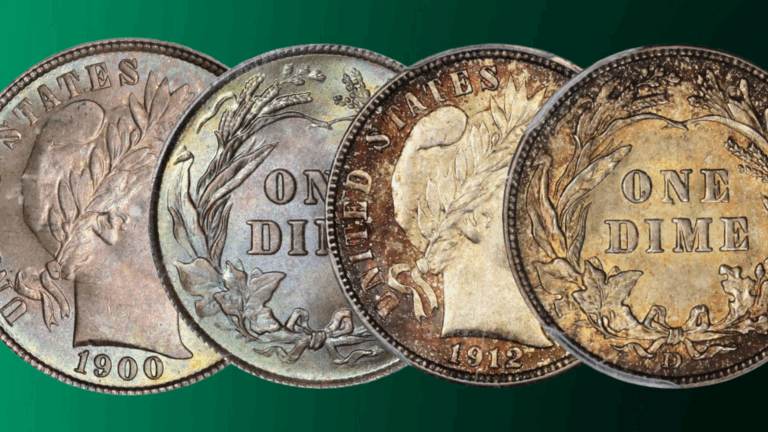by Greg Reynolds
This is an installment in my series on assembling a set ‘by date’ of Liberty Seated half dollars in Very Fine to Almost Uncirculated grades (VF-20 to AU-55), and part of a large series in progress of collecting guides for all classic U.S. coins. Liberty Seated halves ‘With Motto’ AND ‘With Arrows’ were minted for just two years, 1873 and 1874. The motto, ‘In God We Trust,’ was added to the reverse (tail) design in 1866.
The Coinage of Act of 1873 was much different from the Act of 1853, which was path breaking. In 1853, the silver content of half dimes, dimes, quarters and half dollars was reduced. During the early 1850s, the market value of silver increased and the market value of gold decreased. U.S. silver coins became worth more than their respective face values.
After the Coinage Act of 1853 was implemented, newly minted half dimes, dimes, quarters and half dollars became inconsistent with the official government ratio of silver to gold and with definitions of a ‘dollar’ in past laws. In regard to coinage, the federal government had violated its own rules in order to encourage the spending of U.S. silver coins.
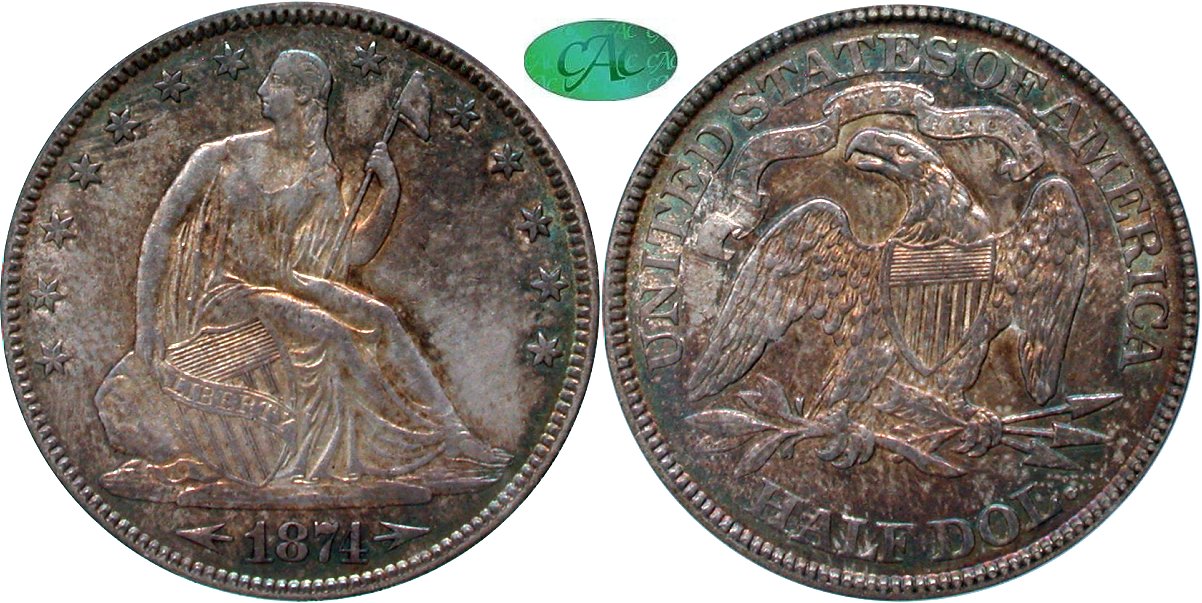
An Increased Value in Silver as Gold Value Decreases
Earlier, the introduction of the Three Cent Silver coin in 1851 brought about the first U.S. silver coin with a silver content specified such that its bullion value was significantly less than its face value; “subsidiary” or “fiduciary” coinage thus began in the U.S in 1851. The coinage system was never again the same, as the official U.S. government definitions of the values of silver and gold were no longer sacrosanct.
Beginning in the 1850s, U.S. citizens gradually became accustomed to the idea of a U.S. silver coin having a face value that was significantly greater than the value of the silver in the respective coin. Experiences during the early 1850s reinforced the reality that the opposite could be true as well; the bullion value of the silver in a silver coin might sometimes be considerably greater than its respective face value.
A decrease in the value of gold and increased investing in silver bullion were not the only reasons why silver coins were sometimes hoarded rather than spent. During wars, economic crises and times of extreme political uncertainty, there was widespread hoarding of silver coins by the American public, especially during the U.S. Civil War (1861-65) and its aftermath. By the 1870s, U.S. silver coins widely circulated again.
“Beginning in the summer of 1873 the U.S. Treasury began to pay out silver coins in exchange for the Fractional Currency,” reveals leading historian R.W. Julian in response to an inquiry of mine in April 2023. From 1862 to 1876, the U.S. government issued paper money in denominations below $1. Although there were six different denominations, just three were part of all five issues of Fractional Currency: 10¢, 25¢, and 50¢. Mostly because of the widespread use of paper money, especially including U.S. 50¢ notes in Fractional Currency issues, mintages of half dollars in Philadelphia from 1866 to 1870 were not large.
Although more than 3.8 million half dollars were minted in Philadelphia in 1843, and more than 3.5 million were struck there ten years later in 1853, plus nearly three million in 1854, the mintage of half dollars in Philadelphia did not surpass 1.2 million again until 1871. In the East and Midwest, half dollars “were in great demand by a public long starved for silver coins. The 1873 and 1874 halves circulated widely,” R. W. Julian emphasizes.
In 1853 and again in 1873, arrows were added to the designs of several silver denominations to reflect the change in weight specifications required by law. The special markings did not have to be arrows; U.S. Mint officials decided that arrows were appropriate. The changes in specifications were determined by politicians. The reasons behind the addition of arrows to the obverse (front) designs of dimes, quarters and half dollars in 1873 were different from the reason for adding arrows to these denominations in 1853.
The Use of Metric Weights of Silver Coins
The Coinage Act of 1873 required the use of straightforward metric measurements for the weights of silver coins. I theorize, however, that politicians were aware that there was little public support for the use of the metric system and that using metric measurements was not then particularly helpful. Most leading politicians in 1873 did not advocate use of the metric system, and many elected officials were against the use of the metric system for all measurements in the United States.
The adoption of metric weights in 1873 for U.S. silver coins relates to the establishment of the Latin Monetary Union (LMU) in 1865 by France, Belgium, Italy and Switzerland. Initially, the LMU was based on the French Franc and a ‘15.5 : 1’ silver to gold ratio. An immediate point here is that the specified gross or total weight of an 1873 half dollar ‘With Arrows’ was 12.5 grams, exactly the weight of 2.5 French Francs. Each French Franc silver coin weighed 5 grams.
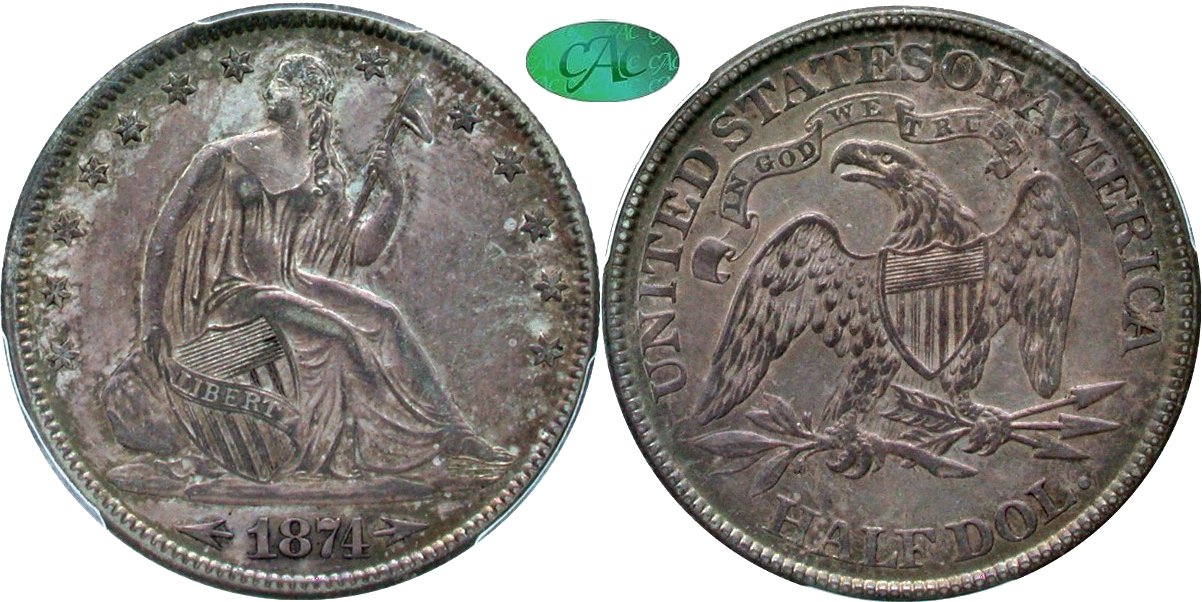
By 1873, it seemed unlikely that an international coinage standard would be adopted during the nineteenth century. Even so, some influential U.S. politicians continued to advocate the concept, and I theorize that this is the reason for the adoption of metric measurements in 1873 that were consistent with the weight of the French Franc, a leading silver coin in Europe. Dreams of and hopes for an international coinage standard continued even after most pertinent politicians came to believe that the idea was impractical or undesirable.
In the nineteenth century, the precise weights of silver and gold coins were tremendously important to politicians and citizens. It was common then to think of precious metals as money and of governments as providing monetary services. Since the 1930s, in contrast, U.S. citizens have tended to think of the national government and the government-appointed Board of Governors of the Federal Reserve system as strongly influencing the money supply and having the ability to ‘create money.’

The Amount of Gold and Silver in Coinage Forever Changed
In the U.S., gold and silver never again played the same roles in the monetary order that they played before 1934. In 1971, President Richard Nixon formally ended the legal relationship between the U.S. dollar and gold; the government was no longer required to peg the value of a U.S. dollar to a specific quantity of gold. His orders extended to silver as well. The ‘silver standard,’ however, had been gradually phased out over the preceding decades especially by policies implemented by President John F. Kennedy circa 1963, including the termination of silver certificates.
Half dollars were specified to be 90% silver from 1837 to 1964, 40% silver from 1965 to 1970 and zero percent silver after 1970 except for half dollars with silver content that were made for collectors or to be sold by the U.S. Mint as souvenirs. All Liberty Seated half dollars were thus legally required to be 90% silver.
The Coinage Act of 1853 reduced the specified gross or total weight of a half dollar from 206.25 grains to 192 grains. For a long time, weights of U.S. coins were officially measured in grains. Converted to grams, the reduction in 1853 of the weight of a half dollar was from 13.365 to about 12.44 grams. The 1853 law, though, allowed half dollars to vary in weight from 12.34 to 12.54 grams, approximately.
Twenty years later, the Coinage Act of 1873 specified the weight of a half dollar to be 12.5 grams, an increase of less than one-half of one percent. Were prepared blanks (planchets) again permitted to vary by 1.5 grains (0.972 gram)? Standard references are inconsistent in regard to this matter. If I correctly interpreted the standards of 1873, prepared half dollar blanks (planchets) were allowed to weigh from 12.4028 grams (191.4045 grains) to 12.5972 grams (194.4045 grains).
Apparently, a half dollar planchet that weighed as little as 12.4028 grams was legal for use before and after 1873. Most of the old half dollar planchets were close to the previous 192 grain (12.44 gram) standard. It is likely that most of the half dollar, quarter and dime planchets (prepared blanks) made while the Coinage Act of 1853 was still in effect could have been legally used to make coins in accordance with the Coinage Act of 1873.
A central point is that there was not a significant change in weight; the change in specifications were political and partly illusory. Nevertheless, the changing of standards, however slight, and the re-introduction of arrows brought into existence new design types, 1873-74 ‘With Arrows’ half dollars, quarters and dimes. By 1875, the arrows were dropped from the designs.
The Re-Introduction of Errors and Different Design Types
There are six dates of this ‘With Arrows – 12.5 gram’ half dollar design type: 1873, 1873-CC, 1873-S, 1874, 1874-CC and 1874-S. As of March 27, 2023, CAC has approved just fifty-three 1873 ‘With Arrows’ half dollars. A substantial number of circulated Liberty Seated half dollars have never been submitted to CAC because most dealers find that it is not cost-effective to submit circulated coins valued at less than $250 each to CAC. Furthermore, for various reasons, many coins valued from $250 to $500 each have also not been submitted. Before the middle of 2023, it was necessary to send a coin first to PCGS or NGC and then to CAC in order for it to be eligible for CAC approval.
After the new CAC office in Virginia becomes operational, raw coins will be accepted by CAC. Moreover, a PCGS or NGC graded coin that failed to receive a CAC sticker in New Jersey or fails to crossover to a CAC holder in Virginia will still be eligible for a CAC grade, if it qualifies for a CAC grade that is lower than its PCGS or NGC certified grade. An immediate point is that additional inexpensive coins and an increasing number of circulated coins will become CAC certified in the future. It may then become easier to collect CAC approved Liberty Seated coins ‘by date.’
It is not particularly difficult to collect ‘With Arrows’ Liberty Seated halves. A CAC approved XF-45 grade 1873 Philadelphia Mint ‘With Arrows’ half would probably retail for an amount between $325 and $450 during the spring of 2023. In February 2022, Gerry Fortin Rare Coins sold a CAC approved VF-25 grade 1873 ‘With Arrows’ half (PCGS serial #24490052) for $200.
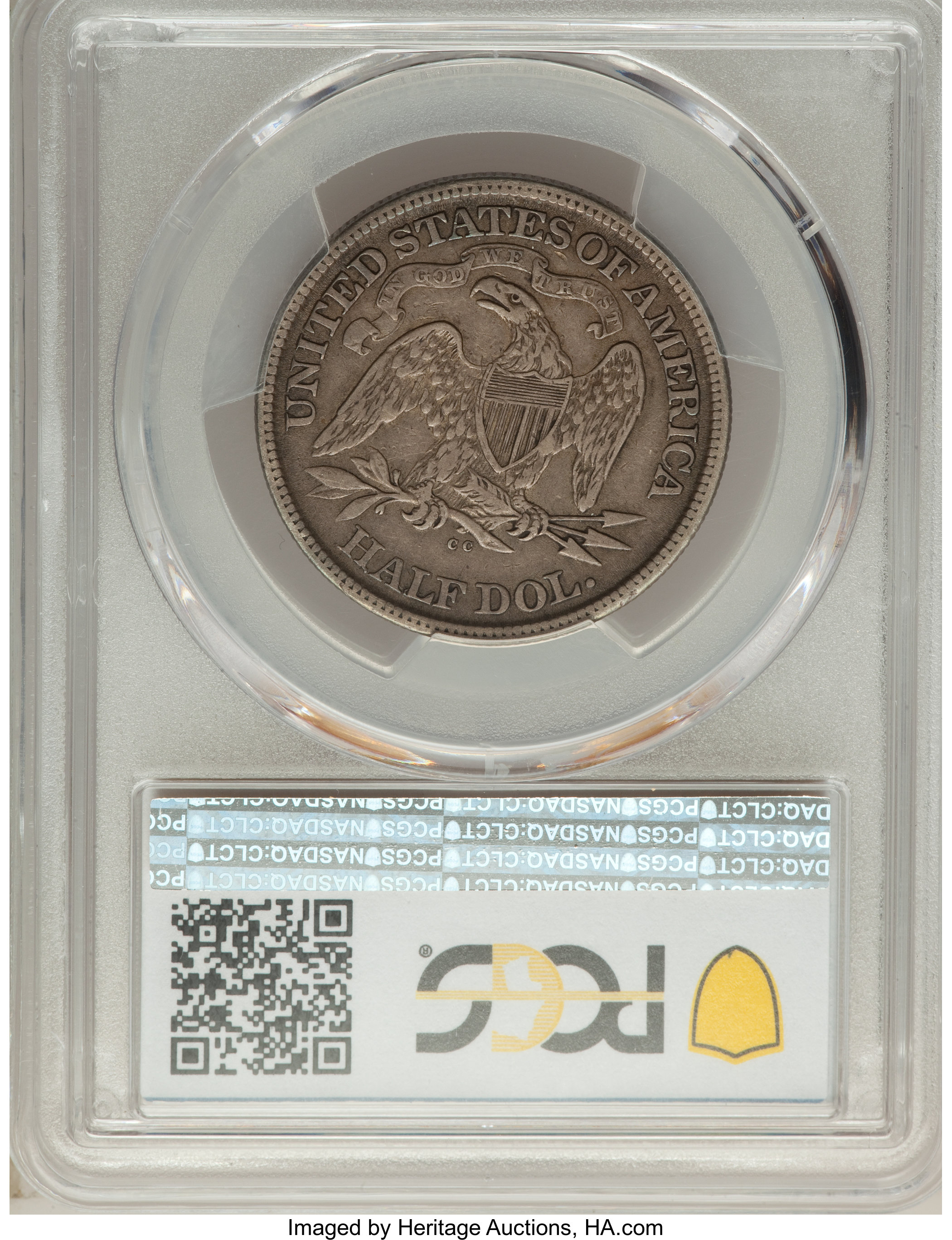
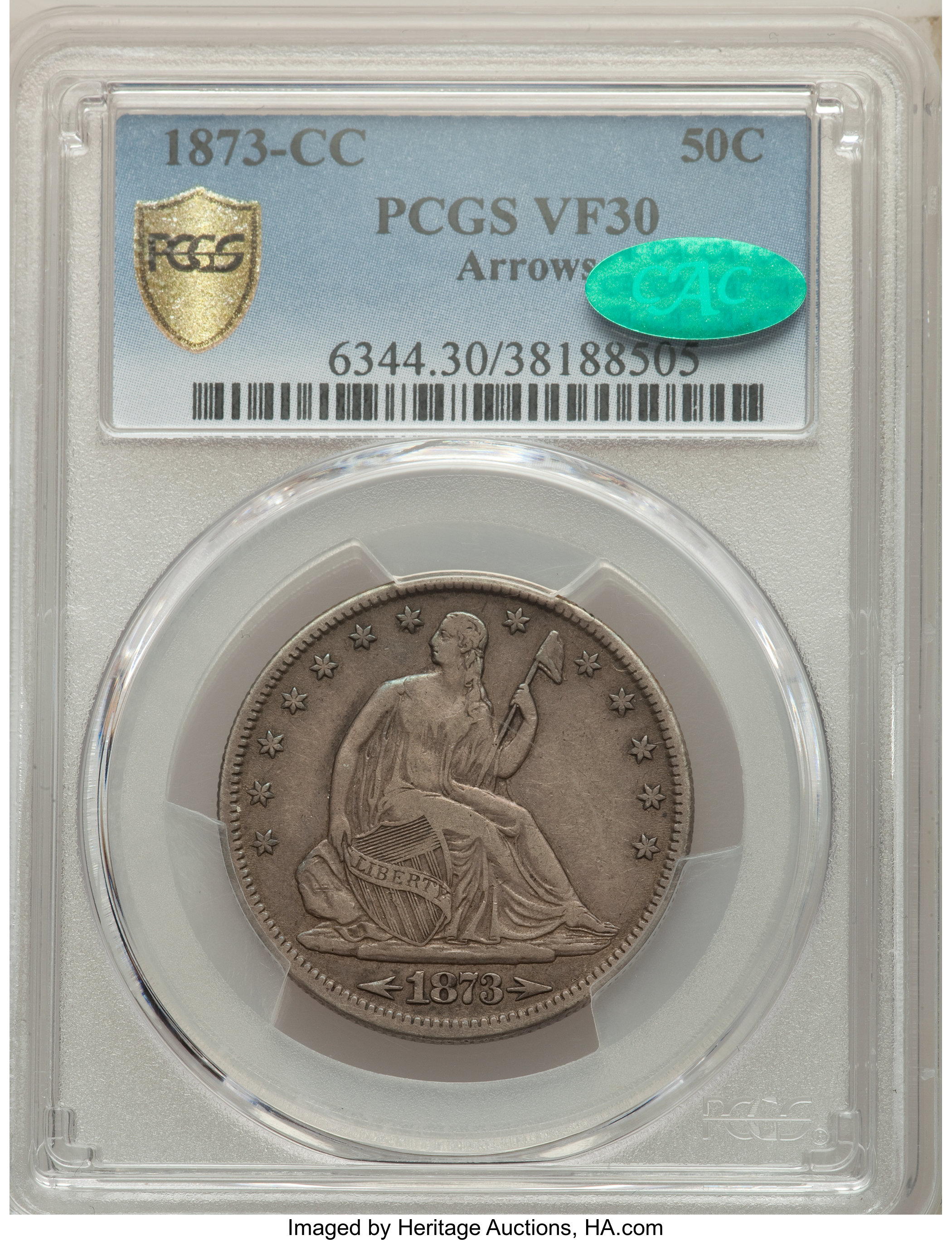
The 1873 Carson City Mint (CC) ‘With Arrows’ half is a very scarce coin. On Aug. 15, 2021, GreatCollections sold a CAC approved VF-30 grade 1873-CC ‘With Arrows’ half for $2036.10. On Sept. 25, 2022, GreatCollections sold a CAC approved XF-40 1873-CC half for $3217.50. In August 2022, Gerry Fortin Rare Coins sold a CAC approved XF-45 grade 1873-CC (PCGS #34406492) half for $3850. Although I probably have not seen these coins, I wonder if the just mentioned VF-30 grade coin is a better value than the XF grade 1873-CC halves that sold for much more?
Half Dollar Very Fine Grades in Comparison to XF to AU
Usually, a VF-30 grade Liberty Seated half has almost as much detail as an XF grade coin. As I have not personally examined all the just mentioned circulated Liberty Seated halves, I cannot draw a conclusion about their respective physical qualities. Nevertheless, it is important to keep in mind that there are many cases where a VF-30 grade coin is technically more impressive than a coin of the same date and mint that has been certified as grading XF-40 or higher by the same service.
Indeed, even a Fine-12 grade coin may have wonderful surfaces while an AU-50 grade coin may have annoying imperfections, often including very noticeable hairlines and/or contact marks. In addition, many coins have been cleaned or have come into contact with various liquids and other substances in the past. Especially for a circulated coin, a numerical grade, even if fair and accurate, does not reveal much about the physical characteristics of the respective coin.
There really is no way to interpret all the leading variables without carefully examining the coins. For collectors who are budget-minded, some Very Fine grade coins may be much better values than XF to AU grade coins of the same respective dates (and mint locations). It makes sense to carefully examine coins and to pose questions to experts.
Over the past forty years, markets for rare coins have evolved such that small increases in numerical grades tend to be correlated with large increases in prices. An AU-58 grade coin could well cost twice as much as an AU-53 grade coin, even if the AU-53 grade coin has more attractive toning and less noticeable contact marks.

Show off Your Collection in the CAC Registry!
Have CAC coins of your own? If so, check out the CAC Registry–the free online platform to track your coin inventory, showcase your coins by building public sets, and compete with like-minded collectors!
CAC Premiums Brought to Collectors with 1873-1874 Half Dollars
While it may not be easy to find a CAC approved 1873-S half that grades below AU-53, each should retail for less than $1000 if offered during 2023. So far, CAC has approved just nine 1873-S ‘With Arrows’ halves, in all grades. In February 2018, Gerry Fortin Rare Coins sold a CAC approved VF-35 grade 1873-S ‘With Arrows’ half dollar for $565.
CAC has approved sixty-five 1874 Philadelphia Mint half dollars. On July 13, 2021, Heritage sold a CAC approved VF-30 grade 1874 for $156. On March 22, Stack’s Bowers auctioned a CAC approved XF-45 1874 for $432.
Carson City, Nevada Coins
Carson City coins are popular. Hundreds of collectors focus on them. The 1874-CC half is very rare, meaning fewer than 250 are known to exist, including 1874-CC halves in all states of preservation. I figure that less than 200 survive, a sizable number of which are heavily worn.
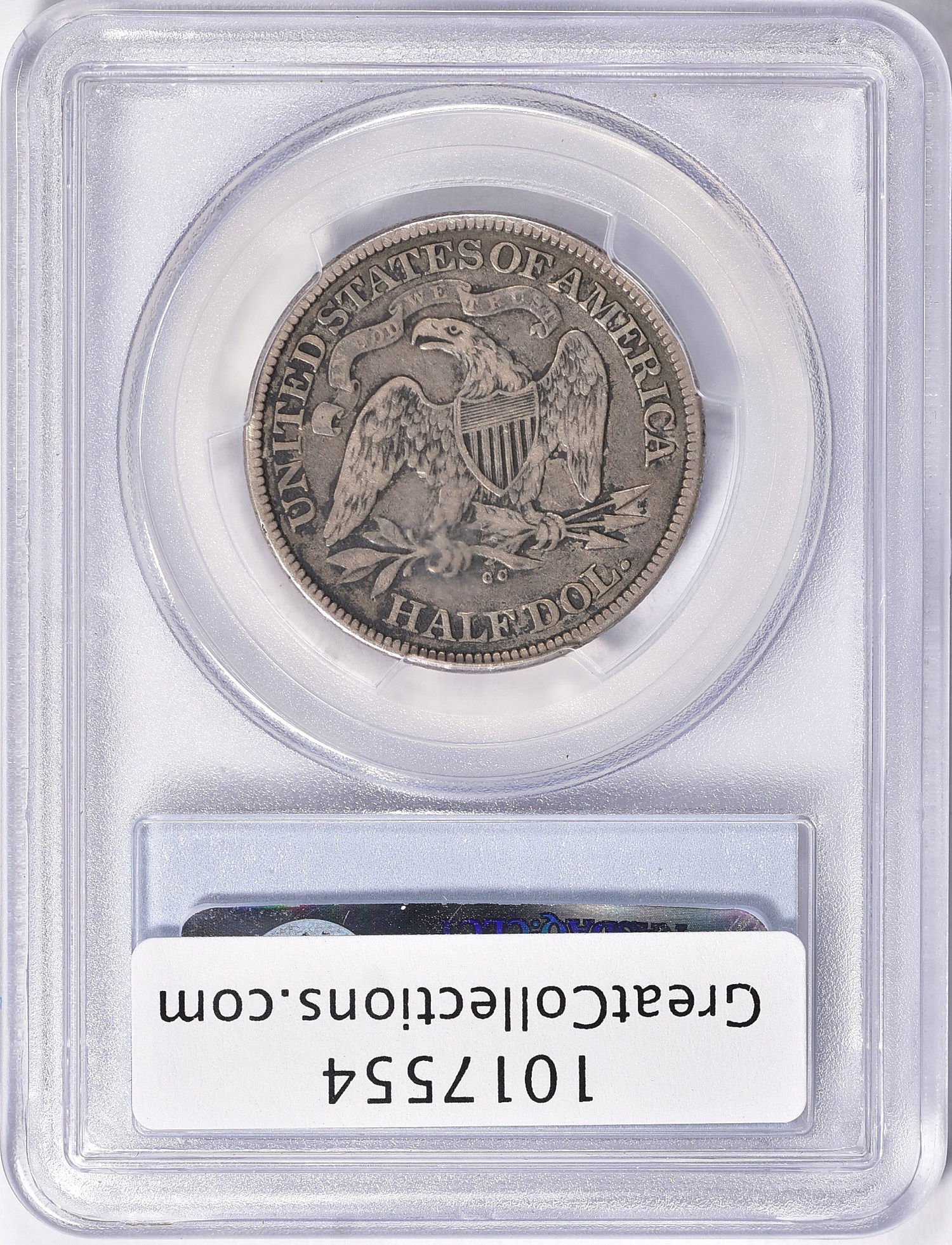
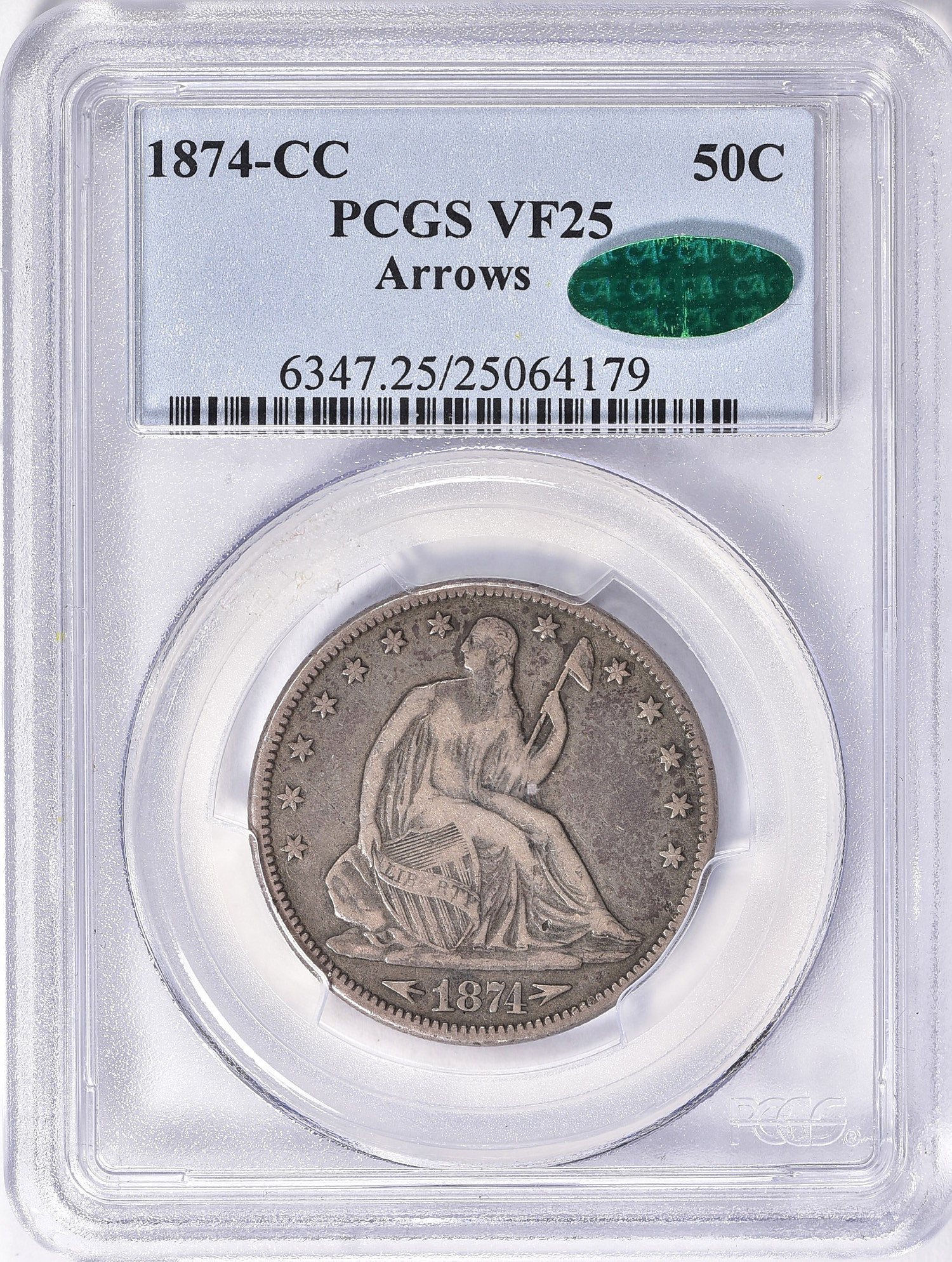
Only 59,000 1874-CC half dollars were minted, all of which had ‘Arrows.’ In contrast, 214,560 1873-CC ‘With Arrows’ halves were minted after 122,500 1873-CC ‘No Arrows’ halves were struck. Mintages in San Francisco were higher. All 1873-S and all 1874-S halves have ‘Arrows.’ Nearly 400,000 1874-S halves were struck, more than 70% above the 1873-S total of 228,000, and greater than six times the number of 1874-CC half dollars.
At the Carson City, Nevada Mint in 1874, the emphasis was upon gold coins and Trade Dollars. After minting 124,500 Trade Dollars in Carson City in 1873, more than ten times as many, 1,373,200, were struck there in 1874. Clearly, 1874-CC Trade Dollars took precedence over 1874-CC half dollars. The policy a year earlier was clearly different, as the number of 1873-CC half dollars minted, 122,500 + 214,560 (=337k), was substantially larger than the number of 1873-CC Trade Dollars, 124,500.
In 1874, the mintage of half eagles (U.S. $5 gold coins) in Carson City, 21,198, was greater than the combined mintage of half eagles in Philadelphia and San Francisco (3488 +16,000 = 19,488). This was true in 1875 as well. Even though the pertinent mintage histories of eagles ($10) and double eagles ($20 gold coins) are not in line with those of half eagles, a point here is that, at the Carson City Mint in 1874, there was a shift away from minting quarters and halves. Additional resources were devoted to Trade dollars and gold coins.
Carson City coins are much rarer than their respective mintages suggest because the vast majority wore down in circulation and were eventually melted. During the 1870s, there were many coin collectors in the Philadelphia area, and very few in or near Carson City, Nevada. Even so, it is practical now to find and obtain an 1874-CC half dollar.
On Nov. 22, 2021, Stack’s Bowers auctioned a CAC approved VF-30 grade 1874-CC for $5760. On March 27, 2022, David Lawrence Rare Coins sold a CAC approved XF-40 grade 1874-CC for $7500. On Aug. 15, 2021, the firm called GreatCollections sold a CAC approved VF-25 grade 1874-CC for $4141.50. In August 2022, Gerry Fortin Rare Coins sold a CAC approved VG-10 grade 1874-CC for $2750.
As Carson City coins have been so popular over the last fifteen years, 1873-S and 1874-S halves are often overlooked. CAC has approved just eleven 1874-S half dollars, only two of which grade below XF-40. Hopefully, more 1874-S halves will be submitted to CAC. In March 2022, Gerry Fortin coins sold a CAC approved VF-25 grade 1874-S for $475.
In sum, there are just six dates of this two-year type. VF-20 to AU-53 grade representatives of these dates are much less expensive than uncirculated (“mint state”) coins. It is not easy to complete a CAC-only set of all six, though this is a sensible objective. Additionally, the historical circumstances surrounding these coins are intriguing.
Images are copyrighted by Stack’s Bowers Galleries (www.stacksbowers.com), DLRC (www.DavidLawrence.com), Great Collections (https://www.greatcollections.com/), and Heritage Auctions (www.ha.com).
Copyright © 2023 Greg Reynolds
About the Author
Greg is a professional numismatist and researcher, having written more than 775 articles published in ten different publications relating to coins, patterns, and medals. He has won awards for analyses, interpretation of rarity, historical research, and critiques. In 2002 and again in 2023, Reynolds was the sole winner of the Numismatic Literary Guild (NLG) award for “Best All-Around Portfolio”.
Greg has carefully examined thousands of truly rare and conditionally rare classic U.S. coins, including a majority of the most famous rarities. He is also an expert in British coins. He is available for private consultations.
Email: Insightful10@gmail.com
